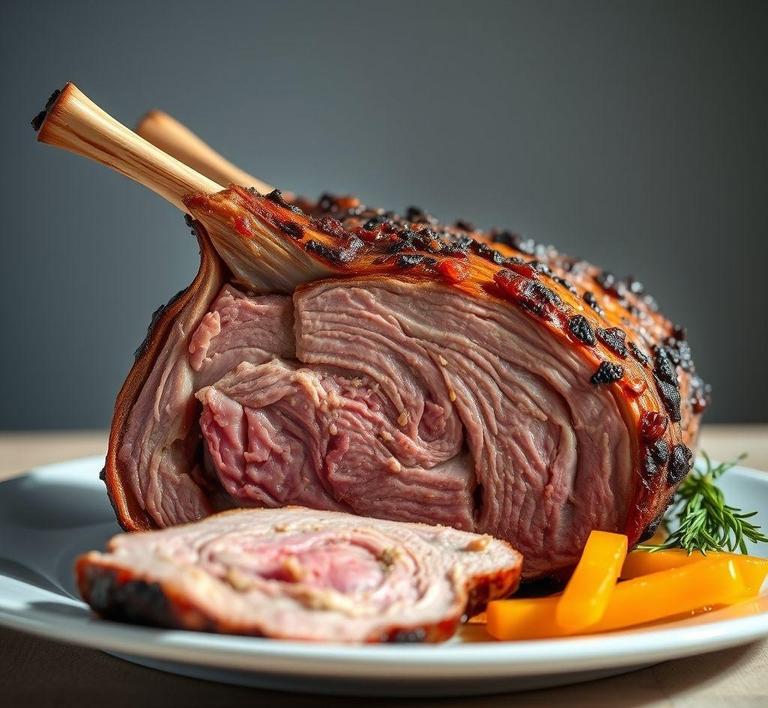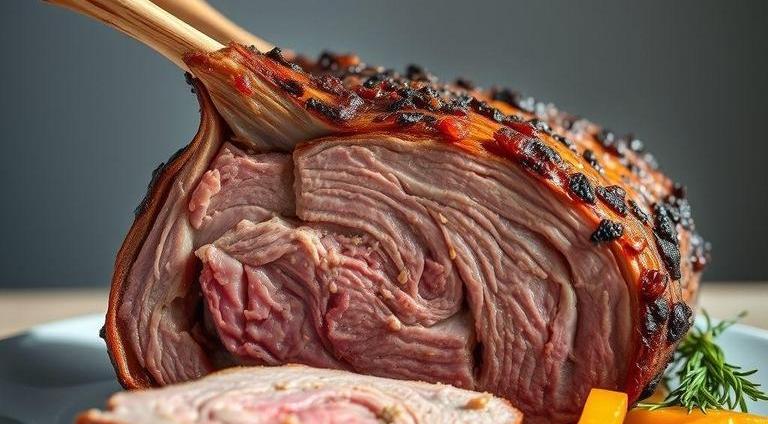Gordon Ramsay’s Roast Leg Of Lamb Recipe [+Tips & Tricks]
Because it’s not just a roast-it’s a culinary journey that transforms a traditional leg of lamb into a centerpiece of rustic elegance, infused with bold aromatics, crisped to golden perfection, and worthy of Michelin-star praise right from your home oven.
What Is Gordon Ramsay’s Roast Leg Of Lamb
Gordon Ramsay’s roast leg of lamb is a celebration of bold, honest flavors. It’s a traditional bone-in leg, marinated with pungent garlic, fragrant rosemary, and earthy thyme, then roasted to juicy tenderness.
What sets Ramsay’s version apart is his balance of simplicity and flair-leveraging natural flavors and classic techniques to draw out the lamb’s richness while maintaining a sophisticated finish. Whether it’s served with a red wine jus or rustic vegetables, this dish evokes everything comforting about Sunday roasts while delivering that signature Ramsay punch of flavor.
Gordon Ramsay’s Roast Leg Of Lamb Recipe
Ingredients Needed

To execute Gordon Ramsay’s roast leg of lamb to perfection, you’ll need a thoughtfully curated blend of herbs, aromatics, and pantry staples:
- 1 whole leg of lamb (around 2-2.5 kg / 4.5-5.5 lbs), bone-in
- 6-8 garlic cloves, peeled and sliced
- A few sprigs of fresh rosemary
- A few sprigs of fresh thyme
- 2 tablespoons olive oil
- Sea salt and freshly ground black pepper
- 1 lemon (zest and juice)
- Optional: Dijon mustard (for crusting), anchovy fillets (for umami boost), and red wine (for deglazing)
- Root vegetables (e.g. carrots, onions, potatoes) if roasting alongside
These ingredients are simple but deliver extraordinary depth of flavor, especially when slow-roasted with love.
Equipment Needed
Here’s the essential gear you’ll want at the ready:
- A sharp paring knife (for inserting garlic and herbs into the lamb)
- Roasting pan or tray
- Meat thermometer (for perfect doneness)
- Kitchen twine (optional, for trussing the lamb if it’s loosely jointed)
- Mortar and pestle or food processor (if making a herby rub or paste)
- Aluminum foil (to rest the lamb after roasting)
How To Make Gordon Ramsay’s Roast Leg Of Lamb?
Step-by-step, here’s how to recreate this masterpiece:
- Preheat the oven to 400°F (200°C).
- Prep the lamb: Using a paring knife, make small incisions all over the leg. Into each slit, insert slices of garlic and small sprigs of rosemary and thyme. These act like little flavor bombs inside the meat.
- Massage and season: Drizzle the lamb with olive oil, then rub it all over with sea salt, cracked black pepper, lemon zest, and juice. For a more intense finish, Ramsay sometimes uses a mustard crust or anchovy paste rubbed into the skin.
- Sear (optional): You can brown the lamb in a hot skillet first for a caramelized crust before roasting.
- Roast: Place the lamb in a roasting pan atop root vegetables or on a wire rack. Roast at 400°F for 20 minutes, then reduce the oven to 350°F (175°C) and continue roasting for about 1 hour and 20 minutes (for medium-rare, internal temperature of 135-140°F / 57-60°C).
- Baste occasionally with pan juices for a glossy, flavorful finish.
- Rest: Remove the lamb from the oven, cover with foil, and let it rest for 15-20 minutes. This allows the juices to redistribute, ensuring tenderness.
- Serve: Slice against the grain and serve with roasted vegetables, pan juices, or a rich red wine reduction.
Expert Tips
- Marinate ahead of time: If possible, marinate the lamb for several hours or overnight with olive oil, herbs, garlic, and lemon for deeper flavor.
- Don’t skip resting: Resting is key to ensuring a moist, tender result.
- Use a meat thermometer: Doneness can be deceiving by sight-go for 135°F for medium-rare, or up to 150°F for medium-well.
- Crust ideas: Ramsay sometimes crusts the lamb with Dijon mustard mixed with breadcrumbs and herbs for added texture.
- Deglaze the pan: After roasting, pour off excess fat and add red wine or stock to the pan. Scrape up the brown bits for an easy, flavorful jus.
Gordon Ramsay’s Roast Leg of Lamb isn’t just a recipe-it’s an experience. It’s where rustic charm meets culinary excellence, allowing you to serve up a dish that’s both heartwarming and restaurant-worthy. Whether for Easter, a Sunday family dinner, or an impressive date night in, this roast delivers on all fronts: taste, texture, and timeless appeal.
Ready to elevate your roast game?
This dish proves that with the right technique and a few classic ingredients, even a humble leg of lamb can become a masterpiece.
Easy Recipe Variations For Gordon Ramsay’s Roast Leg Of Lamb

Gordon Ramsay’s original roast leg of lamb is a symphony of bold flavors-usually infused with garlic, rosemary, olive oil, and Dijon mustard. But the beauty of this dish lies in its versatility. With a few creative tweaks, you can personalize the roast to suit seasonal ingredients, cultural preferences, or dietary restrictions.
-
Mediterranean Twist:
Swap rosemary for oregano and thyme, and replace mustard with a rub made of sundried tomatoes, kalamata olives, lemon zest, and crushed anchovies. Drizzle with extra virgin olive oil and serve with a side of grilled vegetables and tzatziki. -
Moroccan-Spiced Roast:
Coat the lamb with a mixture of ground cumin, coriander, cinnamon, paprika, and turmeric. Add minced garlic, fresh ginger, and a bit of harissa paste for a fiery kick. Serve it with a fluffy couscous salad dotted with dried apricots and fresh mint. -
Herbed Mustard Crust:
Enhance the classic by adding chopped parsley, thyme, and basil to the mustard rub. Mix in lemon zest and a bit of grated Parmesan cheese to create a golden, herbaceous crust. This version pairs beautifully with creamy polenta or a garden pea purée. -
Red Wine & Balsamic Glaze:
Marinate the lamb in red wine, balsamic vinegar, crushed garlic, and rosemary overnight. During the final half hour of roasting, baste with a reduction of the marinade for a rich, slightly tangy caramelized exterior. -
Indian Masala Lamb:
For an exotic spin, coat the lamb with a paste of yogurt, garlic, ginger, garam masala, and chili powder. Roast slowly and serve with warm naan, mint chutney, and curried potatoes.
These variations still honor the fundamentals of Ramsay’s method-high heat to lock in juices, careful seasoning, and patience during roasting-but bring exciting new layers of complexity to the plate.
Best Practices To Store Leftovers
When you’ve indulged in a glorious roast leg of lamb and still find yourself with leftovers (lucky you!), storing them properly is key to preserving flavor and texture for days to come.
-
Cooling and Portioning:
Allow the lamb to cool slightly before handling. Slice or shred it based on your intended use. Keep portions manageable-smaller pieces reheat faster and more evenly, minimizing the risk of drying out. -
Airtight Containers:
Store lamb in airtight glass or BPA-free plastic containers. Separate sauces or jus from the meat if possible to prevent sogginess or spoilage. -
Refrigeration:
Refrigerate within two hours of roasting. Properly stored, lamb will keep in the fridge for up to 3-4 days. -
Freezing for Longer Storage:
For longer storage, lamb can be frozen for up to 2-3 months. Wrap portions tightly in aluminum foil or freezer paper, then seal in freezer bags. Label with the date for easy tracking. -
Reheating Without Drying Out:
To reheat, add a splash of broth or gravy to keep the meat moist. Reheat slowly in a covered dish at 300°F (150°C), or warm gently on the stove in a covered skillet. Avoid microwaving, which tends to toughen the meat.
What Goes Well With Roast Leg Of Lamb?
Roast leg of lamb is a centerpiece that calls for sides that can complement its richness without stealing the spotlight. Here are some inspired pairings:
-
Classic Companions:
• Roasted Root Vegetables: Carrots, parsnips, and potatoes tossed in olive oil, thyme, and sea salt.
• Garlic Mashed Potatoes: Creamy, buttery, and the perfect canvas for soaking up pan drippings. -
Fresh, Green Balances:
• Sautéed Green Beans with Almonds: A fresh, slightly crunchy contrast to the lamb’s tenderness.
• Pea and Mint Purée: Bright, sweet, and herbaceous-a beautiful springtime pairing. -
Grains and Bread:
• Lemon-Herb Couscous: Light and fluffy with subtle citrus notes to cut through the lamb’s richness.
• Crusty Artisan Bread: Ideal for sopping up those luscious juices and roasted garlic. -
Sauces and Condiments:
• Red Wine Jus: Deep, velvety, and tailor-made for roast lamb.
• Mint Sauce or Jelly: A British classic that delivers a sweet-herbaceous lift.
• Chimichurri: A bold Argentine twist with parsley, garlic, vinegar, and chili. -
Wine Pairings:
• Red Wines: Think bold but not overpowering-Cabernet Sauvignon, Syrah, or a Spanish Rioja.
• White Wines: If you prefer white, go for an oaked Chardonnay or a rich Viognier.
Conclusion
Gordon Ramsay’s roast leg of lamb is more than just a meal-it’s a masterclass in balancing simplicity with sophistication. Whether you stick to the signature version or venture into adventurous variations, this dish delivers a show-stopping experience that’s perfect for holidays, family dinners, or Sunday roasts.
Storing leftovers properly ensures the flavors can be enjoyed all week long, transforming into sandwiches, wraps, or even a hearty lamb stew. And when paired with the right sides-from creamy potatoes to vibrant greens and bold sauces-the roast leg of lamb becomes an unforgettable centerpiece worthy of its reputation.
No matter your culinary style, this is a dish that invites creativity and rewards precision. So roll up your sleeves, preheat that oven, and let your kitchen be filled with the scent of rosemary, garlic, and perfectly roasted lamb.
FAQs
What Is The Best Cut Of Lamb For Gordon Ramsay’s Roast Leg Of Lamb Recipe?
Gordon Ramsay recommends using a bone-in leg of lamb for his roast recipe, as it provides the best flavor and texture when roasted.
How Long Should I Cook A Leg Of Lamb For Gordon Ramsay’s Roast Recipe?
Cooking times for a roast leg of lamb vary depending on the size and desired doneness. For medium-rare, roast the lamb for about 20 minutes per pound at 375°F (190°C).
Can I Use A Boneless Leg Of Lamb In This Recipe?
Yes, you can use a boneless leg of lamb, but note that it may cook faster, so adjust the cooking time accordingly.
What Ingredients Are Needed For Gordon Ramsay’s Roast Leg Of Lamb?
The main ingredients include a leg of lamb, garlic, rosemary, olive oil, salt, pepper, and optional lemon zest and Dijon mustard for added flavor.
Do I Need To Marinate The Lamb Before Roasting?
While marinating is not strictly necessary, it can enhance the flavor. Ramsay’s recipe typically involves rubbing the lamb with garlic, rosemary, olive oil, salt, and pepper, and allowing it to sit for about 30 minutes before roasting.
What Is The Secret To A Crispy Crust On The Roast Leg Of Lamb?
To achieve a crispy crust, make sure to dry the lamb thoroughly before seasoning. Additionally, roasting at a high temperature for the first 15 minutes helps to form a golden, crispy exterior.
Can I Cook The Lamb At A Lower Temperature For A Longer Time?
Yes, cooking the lamb at a lower temperature (around 300°F or 150°C) for a longer period can yield a tender roast, but it will not have the same crispy crust as the high-heat method.
How Do I Check The Doneness Of The Lamb?
Use a meat thermometer to check the internal temperature. For medium-rare, it should reach about 125°F (52°C); for medium, 135°F (57°C); and for well-done, 145°F (63°C).
What Side Dishes Go Well With Roast Leg Of Lamb?
Roast leg of lamb pairs wonderfully with roasted vegetables, mashed potatoes, mint sauce, or a fresh green salad.
How Do I Carve A Leg Of Lamb After Roasting?
Let the lamb rest for 10-15 minutes before carving. Slice against the grain to ensure tender, juicy pieces. Start by cutting along the bone, then slice into individual portions.
